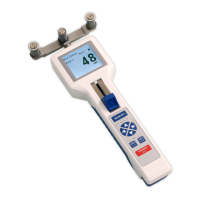–15 –
6.0 CREATING A MATERIAL CHARACTERISTIC
The tension meter has been calibrated on material 1 according our factory procedure
for a vertical material path and cannot be deleted or overwritten. The the materials and
diameters are given in Section 2. Factory calibrations using customer supplied materials
follow the same procedure. In this case, however, the calibration on Schmidt material 1
is omitted
NOTE: The material characteristics 1 has been preset in the factory and cannot be
overwritten. For these material characteristic, you can only change the damping factor,
the alarm function setting, and the limit values.
6.1 Calibration procedure
Calibrations of the tension meter are performed according to the factory procedure
using weights that correspond to 10%, 50%, and 90% of the measuring range. In 95%
of all industrial applications, the factory calibration has been proven to provide the
best results. In particular, it is suitable for comparative purposes. If the material to be
measured differs signicantly from the factory calibration material in material type,
diameter, rigidity, shape, etc., we recommend to perform a calibration using customer-
supplied material. In addition to the two factory-preset materials, you can save up to 9
additional materials.
NOTE: The material thickness unit used for the calibration is the same as currently
selected in the Settings menu. It is not possible to overwrite the factory calibrations.
Calibration Units and Calibration Points
• You can select Newton or Kilogram as the unit of the calibration weights.
• For the calibration of the tension meter, three calibration weights are used.
For example, if you select 10%, 40%, 70% for the calibration, the weights must
correspond to 10%, 40%, and 70% of the measuring range.
In this example, you need the following weights for the DTX-1000:
Calibration in Newton: 100 cN, 400 cN, and 700 cN
Calibration in Kilogram: 100 g, 400 g, and 700 g
NOTE: The measured values are displayed in the unit set in the Settings menu,
independent from the unit that was used to calibrate the material characteristic.
So that they are available when you verify the calibration later or repeat the calibration
after a factory reset.
Material to be
measured
Unit Calibration points
ø 1 ø 2
Steel wire cN 10%, 30%, 50% 0.4 mm 0.6 mm

